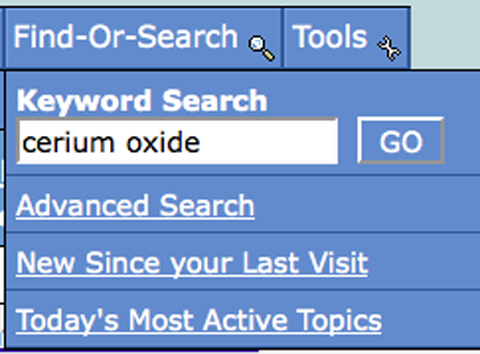
| WWT Shows | CLICK TO: Join and Support Internet Horology Club 185™ | IHC185™ Forums |

|
• Check Out Our... • • TWO Book Offer! • |
Welcome Aboard IHC185™  Internet Horology Club 185
Internet Horology Club 185  IHC185™ Discussion Site Main Page
IHC185™ Discussion Site Main Page  Technical, Shop Talk and Internet Links
Technical, Shop Talk and Internet Links  Watch Repair Questions and Answers
Watch Repair Questions and Answers  a question on PW crystal reconditioning
a question on PW crystal reconditioning
 Internet Horology Club 185
Internet Horology Club 185  IHC185™ Discussion Site Main Page
IHC185™ Discussion Site Main Page  Technical, Shop Talk and Internet Links
Technical, Shop Talk and Internet Links  Watch Repair Questions and Answers
Watch Repair Questions and Answers  a question on PW crystal reconditioning
a question on PW crystal reconditioningGo  | New Topic  | Find-Or-Search  | Notify  | Tools  | Reply to Post  |  |
Greetings all, I know that this subject has been discussed at length on the site but I was looking for the experience of others with this approach: The question: has anyone tried to remove scratches from an old glass crystal using progressively finer grades of automotive emery cloth and water (1000… 2000… 5000 etc..) prior to using cerium oxide powder for the final polish / buffing operation? Is this likely to work or is it a waste of time and effort? What have been your experiences? Look forward to you input, Kindest regards, Serge | |||
|
| Administrative Assistant |
Serge, When utilizing our "Find or Search" feature and typing in the words "Cerium Oxide", I was able to find 34 results. Here are previous discussions that may be of help: Cerium Oxide Debbie  | |||
|
To answer your question, yes if it's a mineral glass crystal. If it's synthetic saphire, forget it. I did one of those old thick beveled edge 18 size crystals for my first customer because I wanted to keep it original if I could. You could not see through this crystal and I wish I'd taken before and after shots but it didn't occur to me at the time. It luckily was a flat one rather than domed so I put 320 wet or dry on a granite machinists block and sanded in one direction only until all the pits were out using lots of water. Then 400 sanding the opposite direction until all the 320 grit marks were gone and on and on until I went to using a "micro mech" kit. I just kept going through the grits and polished it with ZAM when I was done. Perfecto. 18 years later, I end up working with this guy again clear accross the country from where we met at Boeing and he glows talking about his grandpa's watch still sitting on his mantle. | ||||
|
Thanks for your response Tim, I have to give your method another go. I was working on a very thick and old glass crystal but it has crown to it (not flat). I've been able to remove some of the deeper scratches but now have to remove the fine ones I've introduced. PS. Welcome aboard!! Kindest regards, Serge | ||||
|
| IHC Life Member |
Serge, A clean pine or redwood plank makes a good polishing surface and holds a heavy charge of cerium oxide slurry well. The trick is to not get too much water in your slurry while at the same time not letting it dry out and a spray bottle set to "mist" is a good tool for maintaining this balance. Ideally you want to have a lot of drag and when you're generating noticeable heat, work is being done. Ceriun oxide is fast acting and very effective if used correctly but doing this by hand still takes a lot of energy and commitment! William | |||
|
I have found one very good way for using wet & dry emery cloth put the crystal in a dish of water just to cover it. This keep's the cloth clean and will give you a very good polish. | ||||
|
| Powered by Social Strata |
| Your request is being processed... |
|
Welcome Aboard IHC185™  Internet Horology Club 185
Internet Horology Club 185  IHC185™ Discussion Site Main Page
IHC185™ Discussion Site Main Page  Technical, Shop Talk and Internet Links
Technical, Shop Talk and Internet Links  Watch Repair Questions and Answers
Watch Repair Questions and Answers  a question on PW crystal reconditioning
a question on PW crystal reconditioning
 Internet Horology Club 185
Internet Horology Club 185  IHC185™ Discussion Site Main Page
IHC185™ Discussion Site Main Page  Technical, Shop Talk and Internet Links
Technical, Shop Talk and Internet Links  Watch Repair Questions and Answers
Watch Repair Questions and Answers  a question on PW crystal reconditioning
a question on PW crystal reconditioning©2002-2025 Internet Horology Club 185™ - Lindell V. Riddle President - All Rights Reserved Worldwide

